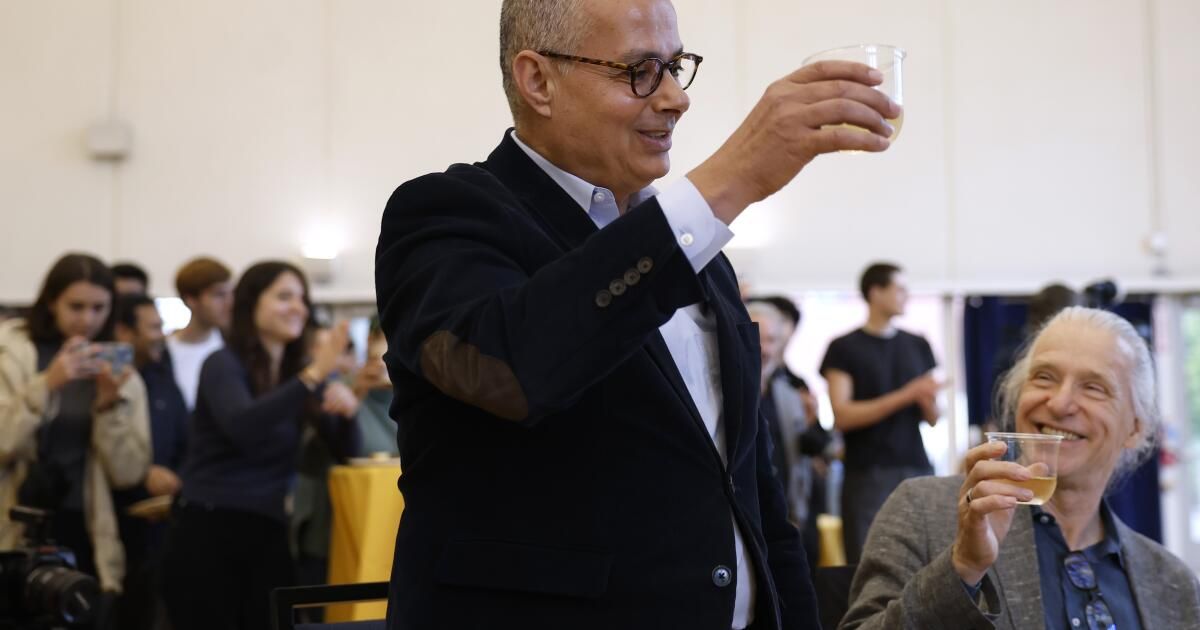Recently, over the course of just three days, five scientists affiliated with the University of California won Nobel Prizes for discoveries that can help us more effectively treat conditions like multiple sclerosis and arthritis, clean pollutants from the atmosphere, capture drinkable water from desert air, and help build the world's most powerful quantum computers.
This is a testament to more than just the research prowess of the UC system. It also demonstrates America's unparalleled leadership in science and innovation, the long-standing partnership between our federal government and our universities, and our country's ability to attract the best and brightest from around the world.
But the symbiotic relationship between the federal government and our universities, which has given so much to America, its people, and its economy, is now at risk.
There are currently plans in Washington to cut research funding by up to 50%, threatening to cede the United States' position as a research leader to other nations, including some of our most determined competitors.
America's global leadership in science did not come about by chance. It took forward-thinking bipartisan policies and years of investment. In 1945, Vannevar Bush, an American scientist who oversaw key research programs that contributed to the Allied victory in World War II, delivered to President Truman an ambitious plan to harness the technological advances that had helped win the war and position the United States for global leadership in the modern era. Their report, “Science, the Endless Frontier,” proposed a new partnership between the federal government and American universities to fund the best research, which would allow serve the US in national defense, medicine and much more. He recognized that American universities could offer the ideal environment for advancing the frontiers of knowledge. They also became a magnet to attract the best students and teachers from abroad.
Over the decades since, the policies and investments of Republican and Democratic administrations alike have formed a bipartisan centerpiece of American politics, cultivating the national research and development arm of the American economy that drives innovation, catalyzes new industries, creates new jobs, and benefits all Americans. With the help of federal funds, university researchers have made advances that are almost impossible to understand: from disease cures and new medications to technological innovations such as cell phones, the Internet and hybrid vehicles.
Since 1945, scientists at American universities have won more than half of all Nobel Prizes in physics, chemistry, medicine and economics. American scientists have also published more research, been cited more frequently by other scientists, and obtained more patents than scientists from any other country.
These are exceptional scholars, recognized for making some of the world's most important scientific contributions. But not even the world's leading scientists and the most prestigious universities can achieve it alone. It is only possible thanks to funding from the National Science Foundation, the Department of Energy, the National Institutes of Health, and other federal government agencies that support research; federal funding that is now threatened.
It is also the result of policies that welcomed the world's most talented and promising students and teachers. Of all the Nobel Prize winners affiliated with American institutions, 35% have been immigrants. Take the example of Professor Omar Yaghi of the University of California at Berkeley: he grew up in Jordan, where his father raised cattle and ran a butcher shop. At the age of 15, after his father obtained a visa, he was sent to upstate New York to continue his education. She studied English and worked hard, packing groceries and mopping floors to pay for school. Last week he won the Nobel Prize in Chemistry, the culmination of the American Dream. When our nation attracts the world's best talent, it generates innovation that benefits Americans, our health and the economy.
We are already seeing the cracks in this system. Uncertainty around federal research funding over the past eight months has caused top researchers to leave prestigious positions at American institutions in search of opportunities in China, Canada and Europe. This “brain drain” will only continue if the United States does not recommit to scientific research. Additionally, international student enrollment is down 20% this year, meaning some of the world's most talented students are choosing to go elsewhere. AND a new and expensive tax for every new postdoc or young researcher on an H1-B visa (an important source of foreign experience to fill unmet needs) will further restrict the flow of talent.
Since 1945, the United States has successfully mastered scientific innovation thanks to visionary leaders, smart policies, and bipartisan support to do what is best for our country. We have been the beneficiaries of a long and successful tradition of investing in science and welcoming the best talent. Only by continuing these efforts can we ensure that the United States remains the leader in global discovery and progress. Without that, everything America has achieved through generations of investment and commitment is at risk.
James B. Milliken is president of the UC system.
Perspectives
Perspectives from the LA Times offers AI-generated analysis of Voices content to provide all points of view. Insights does not appear in any news articles.
Perspectives
The following AI-generated content is powered by Perplexity. Content is not created or edited by the Los Angeles Times editorial staff.
Ideas expressed in the piece.
The UC system president emphasizes that federal research funding and immigration policies have been critical to America's scientific leadership since 1945, when the partnership between the federal government and universities was established through Vannevar Bush's visionary plan. This model has consistently generated innovations ranging from disease cures and new medications to technological advances such as mobile phones, the Internet, and hybrid vehicles. More than half of the Nobel Prizes in physics, chemistry, medicine, and economics since 1945 have been awarded to scientists at American universities, and 35% of all Nobel Prize winners affiliated with American institutions have been immigrants.[1]. The author argues that proposed 50% cuts to federal research funding threaten to undermine this unrivaled competitive advantage. Currently, the uncertainty surrounding federal research funding has already caused measurable damage: top researchers are leaving American institutions for positions in China, Canada, and Europe, and international student enrollment is down 20% this year. Additionally, new taxes on H1-B visas for postdoctoral researchers and young researchers will further restrict the influx of global talent needed to advance American discovery and innovation.
Different points of view on the subject.
The Trump administration's approach to restructuring federal research funding is framed by eliminating what officials characterize as waste and bias in government-funded research.[1]. While the search results indicate this logic, they also reveal that a more diversified funding landscape is emerging to address research support. Alternative sources, including private foundations, startups, and venture capital firms, are beginning to play a larger role in funding scientific research.[2]. State-level programs are stepping in to support research and development, with initiatives like North Carolina's Small Business Innovation Research matching programs and Ohio's Third Frontier program providing funding mechanisms outside the traditional federal structure. Additionally, venture capital firms like Lux Capital are investing directly in academic scientists and early research companies, reportedly committing $100 million to support researchers facing funding challenges.[2]. These developments suggest a shift toward a more diversified, market-driven research funding ecosystem, rather than relying on federal government support as the primary mechanism for sustaining American scientific innovation.












